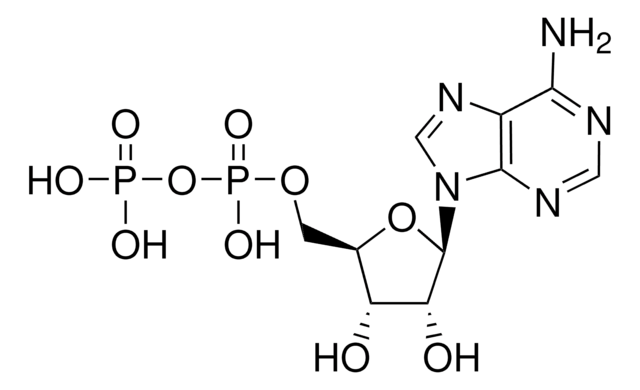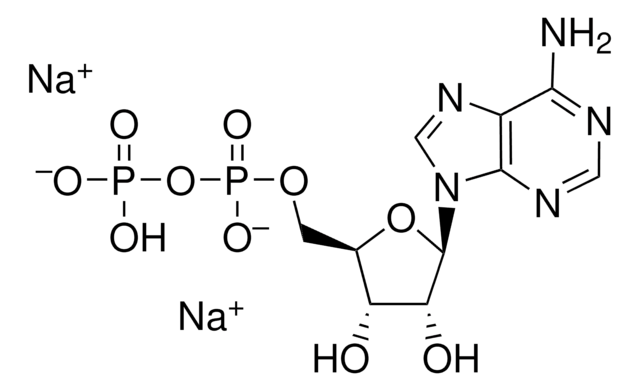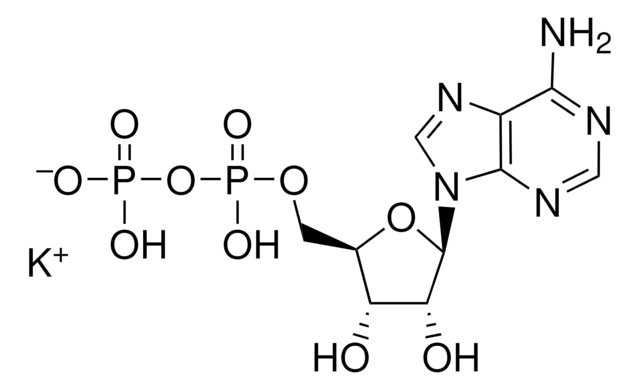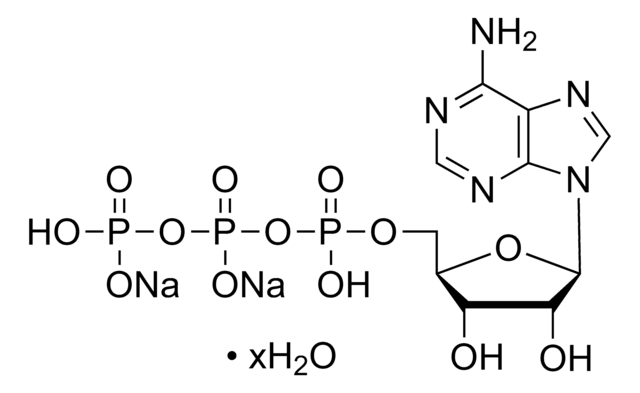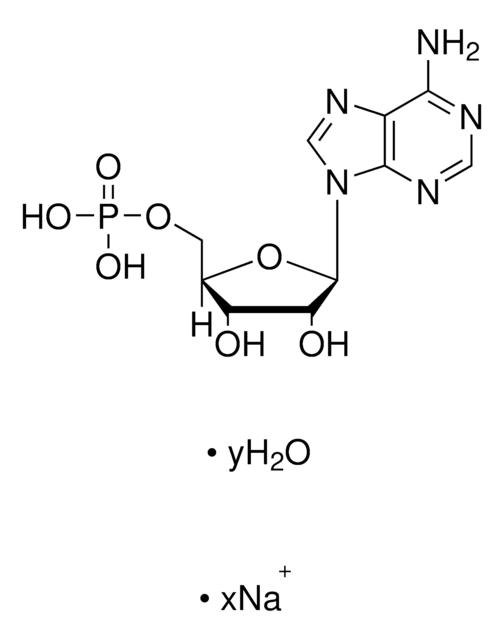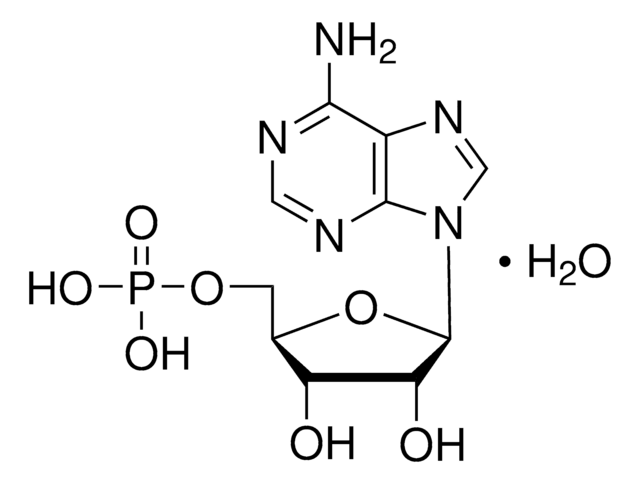A2754
Adenosine 5′-diphosphate sodium salt
bacterial, ≥95% (HPLC)
Recommended Products
biological source
bacterial
Assay
≥95% (HPLC)
form
powder
storage temp.
−20°C
SMILES string
[Na].Nc1ncnc2n(cnc12)C3OC(COP(O)(=O)OP(O)(O)=O)C(O)C3O
InChI
1S/C10H15N5O10P2/c11-8-5-9(13-2-12-8)15(3-14-5)10-7(17)6(16)4(24-10)1-23-27(21,22)25-26(18,19)20/h2-4,6-7,10,16-17H,1H2,(H,21,22)(H2,11,12,13)(H2,18,19,20)/t4-,6-,7-,10-/m1/s1
InChI key
XTWYTFMLZFPYCI-KQYNXXCUSA-N
Gene Information
human ... HSP90AA1(3320) , P2RY1(5028)
Looking for similar products? Visit Product Comparison Guide
Related Categories
General description
Application
- as a positive control of platelet aggregation to analyze antiplatelet activity of purified disintegrin byaggregometery
- in the preparation of stock solution for a mito stress test
- as a positive control in flow cytometry analysis to study the effect of pentameric C-reactive protein (pCRP) and monomeric CRP (mCRP) on the CD62p (P-selectin) expression of platelets
Storage Class Code
11 - Combustible Solids
WGK
nwg
Flash Point(F)
Not applicable
Flash Point(C)
Not applicable
Certificates of Analysis (COA)
Search for Certificates of Analysis (COA) by entering the products Lot/Batch Number. Lot and Batch Numbers can be found on a product’s label following the words ‘Lot’ or ‘Batch’.
Already Own This Product?
Documents related to the products that you have purchased in the past have been gathered in the Document Library for your convenience.
Difficulty Finding Your Product Or Lot/Batch Number?
How to Find the Product Number
Product numbers are combined with Pack Sizes/Quantity when displayed on the website (example: T1503-25G). Please make sure you enter ONLY the product number in the Product Number field (example: T1503).
Example:
Additional examples:
705578-5MG-PW
PL860-CGA/SHF-1EA
MMYOMAG-74K-13
1000309185
enter as 1.000309185)
Having trouble? Feel free to contact Technical Service for assistance.
How to Find a Lot/Batch Number for COA
Lot and Batch Numbers can be found on a product's label following the words 'Lot' or 'Batch'.
Aldrich Products
For a lot number such as TO09019TO, enter it as 09019TO (without the first two letters 'TO').
For a lot number with a filling-code such as 05427ES-021, enter it as 05427ES (without the filling-code '-021').
For a lot number with a filling-code such as STBB0728K9, enter it as STBB0728 without the filling-code 'K9'.
Not Finding What You Are Looking For?
In some cases, a COA may not be available online. If your search was unable to find the COA you can request one.
Which document(s) contains shelf-life or expiration date information for a given product?
If available for a given product, the recommended re-test date or the expiration date can be found on the Certificate of Analysis.
How do I get lot-specific information or a Certificate of Analysis?
The lot specific COA document can be found by entering the lot number above under the "Documents" section.
What is the solubility of Adenosine 5'-diphosphate (ADP) sodium salt, Product A2754?
ADP sodium salt is soluble in water at a concentration of 50 mg/mL.
What is the solution stability of Adenosine 5'-diphosphate (ADP) sodium salt, Product A2754?
ADP sodium salt is stable in solution for several months when stored at pH 7 and at -20 °C. When a solution is stored at pH 7 and 4 °C, the solution is stable for several days. It is unstable in acid.
What are the spectral properties of Adenosine 5'-diphosphate (ADP) sodium salt, Product A2754?
The millimolar extinction coefficient of a pH 7 solution of ADP sodium salt is 15.4 at the absorbance maximum wavelength of 259 nm.
I see that the molecular weight for Adenosine 5'-diphosphate (ADP) sodium salt, Product A2754, on the website does not include sodium, water and solvent content. Why is that?
The amount of sodium, water and solvent for ADP sodium salt will vary from lot to lot. The specific lot information can be found on the certificate of analysis located at our website. To obtain the "true" molecular weight (so that one can calculate the molarity of a solution), the sodium, water and solvent amount must be added to the molecular weight listed on the website.
How do I find price and availability?
There are several ways to find pricing and availability for our products. Once you log onto our website, you will find the price and availability displayed on the product detail page. You can contact any of our Customer Sales and Service offices to receive a quote. USA customers: 1-800-325-3010 or view local office numbers.
What is the Department of Transportation shipping information for this product?
Transportation information can be found in Section 14 of the product's (M)SDS.To access the shipping information for this material, use the link on the product detail page for the product.
My question is not addressed here, how can I contact Technical Service for assistance?
Ask a Scientist here.
Articles
Learn about the four membrane-bound protein complexes that make up the electron transport chain metabolic pathway supplying energy as ATP for cellular respiration.
Get to know the Tricarboxylic acid (TCA) cycle to better inform your research in biochemistry, metabolomics, or related fields concerned with this metabolic pathway and its enzymes, by-products, or intermediates.
Protocols
ZIC-cHILIC is a densely bonded zwitterionic stationary phase with phosphorylcholine functional groups covalently attached to silica.
HILIC separation is an alternative that permits sensitive MS detection and without the use of ion-pair reagents.
Separation of Adenosine 5′-triphosphate disodium salt hydrate, BioXtra, ≥99% (HPLC), from microbial; Adenosine 5′-diphosphate sodium salt, bacterial, ≥95% (HPLC); 2′-Deoxyadenosine 5′-monophosphate, Sigma Grade, 98-100%
Our team of scientists has experience in all areas of research including Life Science, Material Science, Chemical Synthesis, Chromatography, Analytical and many others.
Contact Technical Service